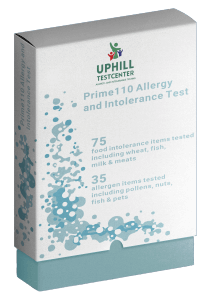What is a food intolerance or allergy
Read here all about food allergy and food intolerance or food sensitivity. We also give you the symptoms and solution for this widely spread problem.
What is a food allergy or food intolerance.
A food allergy, food intolerance or food hypersensitivity, what is actually what and what is the difference . in the following, we want to explain the differences around these terms in more detail. you can then determine for yourself what the problem is. since the difference between food allergy and food intolerance / hypersensitivity is rather large and of a different order, determining one or the other is not a complicated matter.
What is a food allergy?
A food allergy is an immune system response. It is caused when the body mistakes an ingredient in food — usually a protein — as harmful and creates a defense system (antibodies) to fight it. An allergic reaction occurs when the antibodies are battling an "invading" food protein. The most common food allergies are shellfish, nuts, fish, eggs, peanuts, and milk.
What is food intolerance?
Food intolerance is a digestive system response rather than an immune system response. It occurs when something in food irritates a person’s digestive system or when a person is unable to properly digest, or break down, the food. Intolerance to lactose, which is found in milk and other dairy products, is the most common food intolerance.
How common are food allergies and intolerances?
Food allergies affect about 1 percent of adults and 7 percent of children, although some children outgrow their allergies. Food intolerances are much more common. In fact, nearly everyone at one time has had an unpleasant reaction to something they ate. Some people have specific food intolerances. Lactose intolerance, the most common specific food intolerance, affects about 10 percent of Americans.
How can you tell the difference between an allergy and intolerance to food?
Food allergies can be triggered by even a small amount of the food and occur every time the food is consumed. People with food allergies are generally advised to avoid the offending foods completely. On the other hand, food intolerances often are dose related; people with food intolerance may not have symptoms unless they eat a large portion of the food or eat the food frequently. For example, a person with lactose intolerance may be able to drink milk in coffee or a single glass of milk, but becomes sick if he or she drinks several glasses of milk. Food allergies and intolerances also are different from food poisoning, which generally results from spoiled or tainted food and affects more than one person eating the food. Your health care provider can help determine if you have an allergy or intolerance, and establish a plan to help control symptoms.
What are the symptoms of a food allergy?
Symptoms of a food allergy can range from mild to severe, and the amount of food necessary to trigger a reaction varies from person to person. Symptoms of a food allergy may include:
- Rash or hives
- Nausea
- Cramping stomach pain
- Diarrhea
- Itchy skin
- Shortness of breath
- Chest pain
- Swelling of the airways to the lungs
Anaphylaxis is a very serious and potentially fatal allergic reaction that involves a sudden drop in blood pressure, loss of consciousness and body system failure.
What are the symptoms of food intolerance?
Symptoms of food intolerance include:
- Nausea
- Stomach pain
- Gas, cramps or bloating
- Vomiting
- Heartburn
- Diarrhea
- Headaches
- Irritability or nervousness
What causes food allergies and intolerances?
Food allergies arise from sensitivity to chemical compounds (proteins) in food, even compounds that are found naturally in food. Food allergies are more common in people whose family members have allergies, suggesting a genetic — or hereditary — factor may be involved with the development of food allergies.
Food allergies develop after you are exposed to a food protein that your body thinks is harmful. The first time you eat the food containing the protein, your immune system responds by creating specific disease-fighting antibodies (called immunoglobulin E or IgE). When you eat the food again, it triggers the release of IgE antibodies and other chemicals, including histamine, in an effort to expel the protein "invader" from your body. Histamine is a powerful chemical that can affect the respiratory system, gastrointestinal tract, skin or cardiovascular system.
The allergy symptoms you have depend on where in the body the histamine is released. If it is released in the ears, nose and throat, you may have an itchy nose and mouth, or trouble breathing or swallowing. If histamine is released in the skin, you may develop hives or a rash. If histamine is released in the gastrointestinal tract, you likely will develop stomach pains, cramps or diarrhea. Many people experience a combination of symptoms as the food is eaten and digested.
There are many factors that may contribute to food intolerance. In some cases — as with lactose intolerance — the person lacks the chemicals, called enzymes, necessary to properly digest certain proteins found in food. Also common are intolerances to some chemical ingredients added to food to provide color, enhance taste and protect against the growth of bacteria. These ingredients include various dyes and monosodium glutamate (MSG), a flavor enhancer.
Substances called sulfites, which may occur naturally — as in red wines — or may be added to prevent the growth of mold, also are a source of intolerance for some people. The Food and Drug Administration has banned the use of spray-on sulfates to preserve fruits and vegetables, but sulfates are still found naturally in some foods. Salicylates are a group of plant chemicals found naturally in many fruits, vegetables, nuts, coffee, juices, beer and wine. Aspirin also is a compound of the salicylate family. Foods containing salicylates may trigger symptoms in people who are sensitive to aspirin. Of course, any food consumed in excessive quantities can cause digestive symptoms.
How are food intolerances diagnosed?
Most food intolerances are found through trial and error to determine which food or foods cause symptoms. You may be asked to keep a food diary to record what you eat and when you get symptoms, and then look for common factors. For example, after charting what he eats every day for a month, a man finds that he had symptoms only on the days he ate cheese. This points the finger at cheese as a possible cause of his discomfort.
Another way to identify problem foods is an elimination diet. You begin by completely eliminating any suspect foods from your diet until you are symptom-free. You then begin to reintroduce the foods, one at a time. This can help you pinpoint which foods cause symptoms. Seek the advice of your health care provider or a registered dietitian before beginning an elimination diet to be sure your diet provides adequate nutrition.
How are food intolerances treated?
Treatment is based on avoiding or reducing your intake of problem foods and treating symptoms when you do eat a problem food; for example, taking an antacid medication for heartburn or stomachache.
Can food intolerances be prevented?
Taking a few simple steps can help you prevent the symptoms associated with a food intolerance.
- Learn which foods in which amounts cause you to have symptoms, and limit your intake to amounts you can handle.
- When you dine out, ask your server about how your meal will be prepared. Some meals may contain foods you cannot tolerate, and that may not be evident from the description on the menu.
- Learn to read food labels and check the ingredients for problem foods. Don’t forget to check condiments and seasonings. They may contain MSG or another additive that can lead to symptoms.

We will also give guidance on how your individual food intolerances or allergy can be reduced or even eliminated completely.
Discover your trigger items and order your test
SOLUTION FOR YOU

Before $ 119.00

The product images are for illustrative purposes only and do not represent the final digital product
$ 89.00
FOR 1 PERSON
800 FOOD AND NON FOOD ITEMS
Incudes:
Nutritional items
Metal Toxicity
Gut Biome
Digestion
Metabolism Analysis
Support Package:
Qualified Nutritionist Referrel
Free exclusive 19 page guide
6 week Food Diary
24hr (mon-fri) live chat
7-10 Day Lab Processing
Plus 48hr upgrade option
100% money back quarantee
Most favorite product
SOLUTION FOR COUPLES

Save $ 34.00

The product images are for illustrative purposes only and do not represent the final digital product
$ 144.00
FOR 2 PEOPLE
800 FOOD AND NON FOOD ITEMS
Incudes:
Nutritional items
Metal Toxicity
Gut Biome
Digestion
Metabolism Analysis
Support Package:
Qualified Nutritionist Referrel
Free exclusive 19 page guide
6 week Food Diary
24hr (mon-fri) live chat
7-10 Day Lab Processing
Plus 48hr upgrade option
100% money back quarantee
SOLUTION FOR FAMILIES

Save $ 89.00

The product images are for illustrative purposes only and do not represent the final digital product
$ 267.00
FOR 4 PEOPLE
800 FOOD AND NON FOOD ITEMS
Incudes:
Nutritional items
Metal Toxicity
Gut Biome
Digestion
Metabolism Analysis
Support Package:
Qualified Nutritionist Referrel
Free exclusive 19 page guide
6 week Food Diary
24hr (mon-fri) live chat
7-10 Day Lab Processing
Plus 48hr upgrade option
100% money back quarantee
BLOOD SPOT ANALYSE


The product images are for illustrative purposes only and do not represent the final digital product
$ 299.00
FOR 1 PERSON
110 ALLERGIES AND INTOLERANCES
ELISA Testtechnologie
110 Allergies- Intolerances
Test IgE-
and IgG4-antibodies
Support Package:
Qualified Nutritionist Referrel
Free exclusive 19 page guide
6 week Food Diary
24hr (mon-fri) live chat
7-10 Day Lab Processing
Plus 48hr upgrade option
100% money back quarantee
What our clients say about us
Hope for others
I work as a gastrointestinal nurse in a procedure room. We scope patients with a multitude of unexplained symptoms. I can now offer hope to them and share the experience I have had. For me the food intolerance test give the complete solution
Angela
Great help
I wanted an food intolerance and allergy test where I didn’t need to send in blood, and this one uses hair. The results came quickly and have really been a great help.
Sylvie
Pleased with the results of the food intolerance- allergy test
My husband & I did the food intolerance and allergy test. Everything went great. I was very pleased with my results. I would just keep in mind after you mail in your hair sample it takes about 1 weeks to get to the lab.
Esther
We take great care to help you on an individual, personal level.
Here’s how it works:
When you purchase your test, you will receive a short survey. By completing your personal survey, you give us the keys to help discover your best path to feeling good.
How To Order And What To Expect
Choose the single, couple or family hair analysis or blood spot test. Order your test securely through our online shop.
Receive your Easy-To-Use At Home in a simple link
After your purchase, we will send either a testkit for bloodspot testing or an easy-to-use link for hair analysis testing. You click on the link, fill in the form and send it together with a hair sample to our laboratory. The testkit for the bloodspot test contains comprehensive and easy to follow instructions
Get Your Results
You will get a complete and accurate report of your results by email in as fast as 7-10 business days after we have received your samples. You’ll also get personalized, exclusive guides that are designed to help you to lessen, or even eliminate, your symptoms.
Personal Advice
Regarding the outcome of your results we will give you actionable, valuable tips and advice from our nutritionists (which followed a comprehensive study to be certified nutritionist) on how to maintain a healthy lifestyle All this on a per-person basis, as no single human or case is the same. We are here to help you.
YOUR HEALTH IS NOT AN EXPENSE,
IT'S AN INVESTMENT
The Most Complete and Accurate Food Intolerance Test. Receive an extensive report on the food and non-food products that can give you stomach issues, bloated feelings or make you feel sick and tired. You can check out the items we test by clicking here.
Blood- or Hair Testing
We now offer you the most comprehensive bloodspot- or hair test where your samples are tested against common substances, along with a whopping 800 items.
Best Value Available
Not only do you get the best price for your investment in your health, but you also get the most accurate and complete results by testing blood or hair samples.
Fast Accurate Results
Your personal and detailed results in 7 to 10 business days in your mailbox after we have received your samples at our labs.
Comprehensive Report
Get your easy to follow report through email that exposes any allergens or toxic substances. You also get nutritional expertise to get you back on track.
Professional, Personal Care
Effectively reduce or even eliminate your symptoms with personal guidance and get expert assistance to help you achieve your individual results.
100% Money-Back Guarantee
No questions asked, risk-free, 100% Guarantee! If you’re not satisfied for any reason, we give you your money back. It’s that simple.
OUR TESTS ARE DEFINED AS NON-IGE-MEDIATED. ALSO REFERRED TO FOOD INTOLERANCE TESTS
The Most Advanced Equipment
Testing is carried out with cutting-edge technology, using one of the most advanced Certified Class 11 Medical scanners accredited devices according to ISO EN 13485 available in the world today. The hair sample is placed into the equipment – each item is tested line by line against the recorded resonances of all 800+ items.
Our laboratory assistants set the equipment to record any items showing a difference in frequency of 85% or above.
The same equipment is used in the Russian space project and by more than 7000 practitioners in Germany, Austria and Switzerland. This exact testing equipment is used by both Olympic and professional sports teams.
If you believe you have a medical condition or you are seriously ill, you need to discuss with your general practitioner (GP). However, a growing number of people are discovering the benefits of bio-resonance therapy.
Hair analysis is approved worldwide including the FDA and is now seen as a serious alternative to blood testing.
We use ELISA testing technology for testing your blood samples. Both IgE and IgC4 are tested
By testing both IgE and IgG4 antibodies we give you a more comprehensive picture of possible causes to symptoms. Raised IgE levels (IgE, short for “immunoglobulin E,” is the antibody that triggers food allergy symptoms) indicate allergy symptoms. Raised IgG4 (Immunoglobulin G) antibodies indicate a food intolerance or sensitivity. IgG4 responses are actually more common than the IgE, which causes an immediate reaction.
Food intolerance/sensitivity reactions are more difficult to notice since they can occur hours or even days after consumption of an offending food.
Do You Have Questions?
Here are a few common questions asked by our community.
If you don't see your question here, get in touch with us and our
dedicated customer support team will help you find an answer.
Not seeing your question? Please do contact us!
Our Certified Nutritionists are happy to assist you with any of your concerns or questions.
Click for all your questions
Disclaimer:
Hair tests (Bioresonance Therapy) is categorised as Complementary and Alternative Medicines (CAMs) covering therapies that fall outside mainstream medicine. Conventional medicine does not currently recognise Bioresonance as it has not been subject to significant scientific research. Bioresonance reports and related information do not make a medical diagnosis nor is it intended to be a substitute for professional medical advice, diagnosis, or treatment.Always seek the advice of your doctor or other qualified health provider if you have a medical condition and/or medical symptoms. Never disregard professional medical advice or delay in seeking it because of something you have read on this website. All probable or possible information provided in reports or on this website need to be discussed and confirmed with a nutritional therapist or qualified medical practitioner.
All probable or possible diagnoses generated by the test or this website need to be discussed and confirmed with a qualified medical practitioner. If you think you may have a medical emergency, call your doctor or the emergency services immediately. Reliance on any information provided by this Website is solely at your own risk. Some of the content on this Website may be provided by third parties and we are not in a position to verify this content. We do not warrant that any such third party content is true, accurate or complete. Our test does not measure type IgE allergies or IgG antibodies. Since these reactions can be serious, you should seek the help of an allergy specialist.
Enter your text here...
Download Free copy of Warning Signs for Food Sensitivity